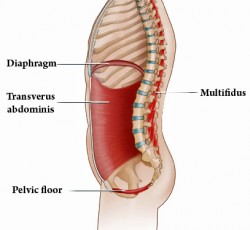How many times have you heard a PT say “switch your core on!” ? While this is great advice if you know exactly what to do, if you don’t know what the heck they’re talking about, then it’s absolutely useless information. When we talk about our ‘core’ we’re talking about the muscles in the middle of our body in and around our torso. This is the area that supports our major organs, our spine, maintains posture, and generates almost all movement that occurs in the body. So you could say it’s pretty important! Around our ‘core’ there are a variety of muscles which work together to stabilise and generate movement. These can be broken down into two categories
1. Stabiliser muscles
2. Power muscles
Stabilisers
These are the deeper muscles which work together to stabilise and keep the body erect. They support the internal organs and maintain intra-abdominal pressure to support breathing and protect the spine during movement. These muscles form a cube around our torso and have a high percentage of slow twitch muscles fibres this means they are built for endurance = they need to be active for long periods of time. They are often neglected because they can be hard to activate, and they are not visible on the surface. The core stabilisers include
- Transverse abdominis – deep abdominal muscles that acts like a girdle
- Multifidis – Deep muscles in the spine to support posture
- Internal obliques – on each side involved in twisting and lateral flexion
- Pelvic floor – Supports the internal organs
- Diaphragm – Supports the lungs
Power Muscles
These are the shallower or more superficial muscles that are responsible for generating major movements including flexion and extension in the trunk. They have a higher percentage of fast twitch muscle fibres, they are used for short bursts of activity rather than long periods of endurance like the stabilisers. These tend to be the muscles that get all of our attention in the gym – because they’re the ones we can SEE! These include
- Rectus abdominis – 6 pack muscle
- Erector spinae – muscles that run up the spine generating spinal extension
- External obliques – assists with twisting and lateral flexion
- Hip flexors – Flex the hips and torso forward
- Gluteus maximus – Extend the hips and torso backwards
Activating the deep abdominals
The ‘ab’ exercises you do in the gym include things like crunches, hip lifts, twists, bicycles etc, while stabilisers are always involved, these exercises will primarily be targeting the power muscles. The key to activating and training the deeper, abdominal stabiliser muscles is to have the pelvis tilted into the correct position, and to consciously contract the deep transverse abdominis using the stomach vacuum.
Stomach Vacuum
Exhale completely, pull your belly button in towards your spine like you’re sucking in your tummy, while puffing out your chest and hold for as long as possible. You should feel your transvers abdominis contracting all the way around your middle like a corset tightening. This can be performed standing, sitting, lying or kneeling.
When your PT tells you to ‘switch your core on’ – this is what we mean!
By having these deep abdominal muscles active throughout ALL your exercises you will help to increase strength and endurance in these muscles, which will help to protect your lower back from injury and promote good posture and powerful movements.
In conclusion
Make sure when you’re training on your own or with your Trainer, you remember to properly position your pelvis and engage your deep core muscles to reap all the benefits of core training – as well as just building your 6-pack!


